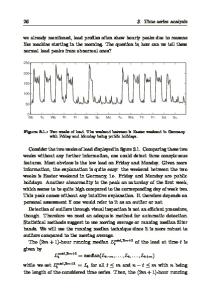Time Series Analysis of Acoustic Emissions in Prefabricated Utility Tunnel During the Sealing Test
- PDF / 1,007,681 Bytes
- 9 Pages / 595.276 x 790.866 pts Page_size
- 105 Downloads / 278 Views
(2020) 6:55
ORIGINAL PAPER
Time Series Analysis of Acoustic Emissions in Prefabricated Utility Tunnel During the Sealing Test Zhenzhen Lin1 · Jianqing Deng1 · Huihuan Ma1,2,3,4 · Pengpeng Ni1,2,3,4 · Chengchao Guo1,2,3,4,5 Received: 11 October 2020 / Accepted: 29 October 2020 © Springer Nature Switzerland AG 2020
Abstract Utility tunnel is increasingly applied for underground space development, and its health monitoring becomes attractively important. The acoustic emission (AE) technology is often used for damage monitoring of small-scale specimens made of concrete or rock in the laboratory. In this study, the AE technology is adopted to instrument a novel prefabricated utility tunnel to provide insights into the leakage behavior of the structure during the sealing test. Filtering is conducted on AE data to eliminate the influence of noise interference, especially for data in the pressurization stage. The traditional ring-down count and AE energy are determined from eigenvalue analysis of AE events. It is found that these conventional calculations can be well related to the pattern of internal water pressure, and the Felicity effect is found in the loading process. Furthermore, time series analysis is carried out for each specific pressurization or pressure-holding stage during the sealing test, in which the b-value (an important mean to study the characteristics of AE signal) is evaluated. Results show that the b-value can also be used as a prediction basis for pre-alarming monitoring before the occurrence of seepage failure for utility tunnel. Keywords Utility tunnel · Sealing test · Acoustic emission · b-Value · Ring-down count · Energy
Introduction With the advancement of underground space development, it is vital to solve underground congestion and minimize repeated excavation due to maintenance [1, 2]. As a result, utility tunnel is proposed and implemented increasingly, in which lifeline networks, in terms of water supply pipes, sewage pipes, oil and natural gas pipes, and lines for electric power communication and transportation, are integrated [3]. The use of utility tunnel meets the United Nations’ requirements for sustainable social and public development [4], and * Pengpeng Ni [email protected] 1
School of Civil Engineering, Sun Yat-Sen University, Guangzhou 510275, China
2
Southern Marine Science and Engineering Guangdong Laboratory (Zhuhai), Zhuhai, China
3
Guangdong Key Laboratory of Oceanic Civil Engineering, Guangzhou, China
4
Guangdong Research Center for Underground Space Exploitation Technology, Guangzhou, China
5
Southern Institute of Infrastructure Testing and Rehabilitation Technology, Huizhou, China
has been promoted by different countries. For example, in China, the length of utility tunnel has exceeded 7000 km, such that China has the longest distance of pipe corridor compared to other countries [5, 6]. As an underground structure, the maintenance and monitoring of utility tunnel are extremely crucial [7, 8]. The structure of utility tunnel is often made i
Data Loading...











